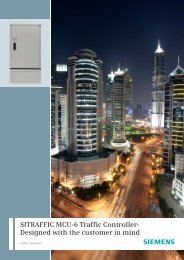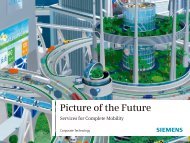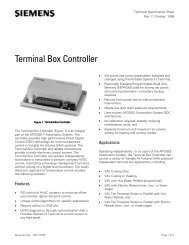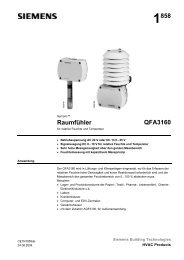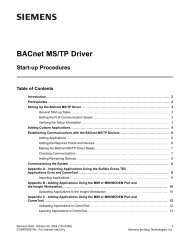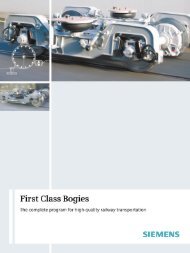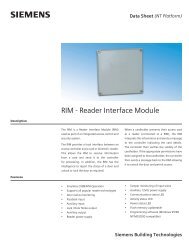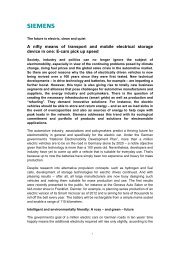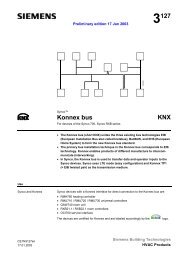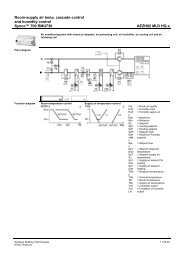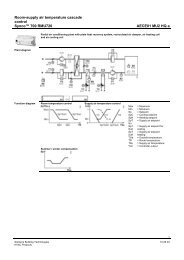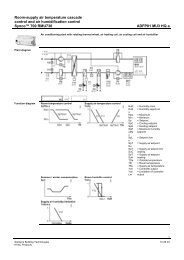UTC System Handbook - Siemens
UTC System Handbook - Siemens
UTC System Handbook - Siemens
Create successful ePaper yourself
Turn your PDF publications into a flip-book with our unique Google optimized e-Paper software.
<strong>System</strong> <strong>Handbook</strong> for an STC <strong>UTC</strong> <strong>System</strong> 666/HE/16940/000<br />
An additional "LF3" lamp failure reply bit is available as a configurable<br />
item. See section 2.3. "LF3" is associated with the unidentified lamp fault.<br />
(15) Group 1 Indication - GP1<br />
The "GP1" reply bit is output by some types of controller at the start of its<br />
group 1. This is then checked during controller checks, section 7.14, to<br />
ensure that all such controllers are synchronised, see also section 7.1.2(9).<br />
(16) Remote Reconnect - RR<br />
When the <strong>System</strong> sees an "RR" reply bit it isolates the controller and reports<br />
a fault. Normally when the RR bit is set the <strong>UTC</strong> <strong>System</strong> will not monitor<br />
the controller for faults. However, the <strong>System</strong> may be configured (S) to<br />
generate the appropriate fault messages when the MC, EV or HC bits are<br />
set.<br />
When the bit clears all faults associated with the controller and its OTU are<br />
cleared, the clearance is reported and the controller's isolation cancelled.<br />
Maintenance personnel normally use this facility after having fixed a fault.<br />
In the UK a controller can be configured so that the bit is set when the mode<br />
switch in the controller is moved away from its normal position.<br />
(17) Manual Control - MC<br />
The presence of the "MC" reply bit in a controller's reply word indicates to<br />
the <strong>System</strong> that the controller has been taken out of the normal <strong>UTC</strong> mode<br />
and is in the Manual Control mode. Its action is similar to the remote<br />
reconnect facility, section 7.1.3(16), except that its disappearance does not<br />
clear the faults for equipment on the OTU. It is normally used to indicate<br />
that the police have taken manual control of the junction.<br />
(18) Pedestrian Inhibit- PI<br />
The presence of the "PI" reply bit in a controller's reply word for 3 or more<br />
consecutive seconds raises a non-isolating fault and outputs a message to<br />
the <strong>System</strong> log. When the bit disappears for 3 seconds or more the fault is<br />
automatically cleared and a message output to the log. Plan compliance<br />
continues whilst this fault is active and if the pedestrian stage was<br />
demanded by the computer then the junction has a plan compliance fault<br />
raised.<br />
(19) Test Facility- TF<br />
The presence of the "TF" reply bit in a controller's reply word indicates to<br />
the <strong>System</strong> that the controller has been taken out of the normal <strong>UTC</strong> mode<br />
and is in the Test Facility mode. Its action is similar to the remote reconnect<br />
facility, section 7.1.3(16), except that its existence for 3 or more seconds<br />
raises a non-isolating alarm and outputs a message to the <strong>System</strong> log, and its<br />
disappearance outputs a message informing the end of the test facility. It is<br />
normally used to indicate that the junction is being tested.<br />
(20) Solar Bright confirm - SB<br />
NOTE: This and the Dimming Confirm bits are mutually exclusive - only<br />
one is available on a system at a time, being defined in the <strong>System</strong><br />
configuration.<br />
666-HE-16940-000.doc Issue 31 Page 38




